
Volume
27, No. 6 – June 2014
Volume 27, No. 6
Editor: Stephen L. Seftenberg
Website:
www.CivilWarRoundTablePalmBeach.org
President’s Message
What an exciting six months we have had at the Round Table! Thank you
to everyone who has supported our efforts through your dues and
donations and participation in our programs. Special recognition goes to
Robert Franke and Marshall Krolick for their outstanding efforts in
making our guests speaker’s visits possible. In December 2013,
world-famous author Robert Macomber’s entertaining account of the role
of the Bahamas in the Civil War highlighted our Holiday Party. In
January, General Dan Sickles (embodied by member William McEachern)
returned from "the other side" for a unique interview by intrepid
reporter, Lavinia Lovejoy Lawrence (embodied by President LaRovere). In
February, Larry Hewitt discussed "Civil War Myths and Mythmakers." In
March, 105 attendees listened as Dr. James "Bud" Robertson discussed his
new book, "The Untold Civil War." In April, member, Dr. Robert Altman
discussed veterinary and human medicine. And in May, the dynamic duo of
Dr. Gordon Dammann, founder of the National Museum of Civil War
Medicine, Frederick, Maryland, and his son, Douglas Dammann, Curator of
the Civil War Museum of Kenosha, Wisconsin, shared the stage.
We had outstanding attendance at each of these programs. However, the
record for the number of members attending a program was set by
Roundtable member Dr. Marsha Sonnenblick, ably assisted by her husband,
Dr. Bernie Sonnenblick. The subject was "Sex and the Civil War," given
on Valentine’s Day 2013! Sex always draws a crowd!
June 11, 2014 Program
Craig Freis has been collecting autographs, historical documents, and
old newspapers for over forty years. Craig will bring actual editions of
newspapers such as The New York Times and the New
York Herald dated between 1850 and 1870. Round Table members
will have the opportunity to read about social, economic, and political
topics as well as news and casualties from the battlefront. Feel tired
and run down? Read about the latest elixir advertised in the newspaper.
The print is very, very small so please
bring a magnifying glass or very strong glasses. Craig is a retired
investigator in the mental health system in New York.
May 14, 2014 Program
 Gordon
E. Dammann, DDS, and his son, Douglas Dammann, combined to give us two
fascinating talks. Doug was first on the bill. Kenosha, Wisconsin, is a
town of 100,000 equidistant from Chicago and Milwaukee. The Museum is
one of three museums opened by the City of Kenosha in 2008. Member
Marshall Krolick served as a curator and loaned the Museum many items
from his personal collection. We are the lucky benefactors of the fact
that Gordon and Doug drove to Florida to return these items and agreed
to speak to us. The Civil War Museum draws 75,000 visitors a year (out
of 235,000 a year total for the three museums). Why choose Kenosha?
There are few battlefields to visit, but 750,000 young men from
Minnesota, Iowa, Wisconsin, Illinois (250,000 alone), Indiana and
Michigan went off to "See the Elephant." In addition, the Middle Western
states supplied iron ore, grain, horses, mules, foodstuffs, etc. "Seeing
the Elephant" was the term Civil War soldiers used to say they saw
battle and is the title of the Museum’s 11-minute 360-degree Cyclorama
that puts you right in the middle of the battle. Gordon
E. Dammann, DDS, and his son, Douglas Dammann, combined to give us two
fascinating talks. Doug was first on the bill. Kenosha, Wisconsin, is a
town of 100,000 equidistant from Chicago and Milwaukee. The Museum is
one of three museums opened by the City of Kenosha in 2008. Member
Marshall Krolick served as a curator and loaned the Museum many items
from his personal collection. We are the lucky benefactors of the fact
that Gordon and Doug drove to Florida to return these items and agreed
to speak to us. The Civil War Museum draws 75,000 visitors a year (out
of 235,000 a year total for the three museums). Why choose Kenosha?
There are few battlefields to visit, but 750,000 young men from
Minnesota, Iowa, Wisconsin, Illinois (250,000 alone), Indiana and
Michigan went off to "See the Elephant." In addition, the Middle Western
states supplied iron ore, grain, horses, mules, foodstuffs, etc. "Seeing
the Elephant" was the term Civil War soldiers used to say they saw
battle and is the title of the Museum’s 11-minute 360-degree Cyclorama
that puts you right in the middle of the battle.
 Doug
then introduced us to Carolyn Quarlls (1850-1910), a light-skinned slave
who could pass for white. On July 4th, 1842, Caroline Quarlls, with $100
she had secretly accumulated, left family, friends, and the only life
she'd known behind in St. Louis, Missouri. As the child of a slave
mother and a slave-owner father, her young life was one of drudgery and
obedience until that fateful Independence Day when she illegally took a
steamboat across the Mississippi River from St. Louis to Alton,
Illinois, in the hope of reaching freedom. With the help of
abolitionists, especially her "conductor," Lyman Goodnow, of
Prairieville (now Waukesha), Wisconsin, the 16-year-old traveled through
Illinois, Wisconsin, Indiana, and Michigan on the Underground Railroad,
enduring long, bumpy rides in the bottom of wagons and taking cover in
everything from barrels to potato chutes. Each step of the way, Quarlls
was pursued by lawyers paid to retrieve her and bounty hunters greedy
for the reward money (If she escaped, the steam boat company would have
to reimburse her owner for her "value") and was nearly caught in
Milwaukee because of the treachery of a black barber who pretended to
hide her. Finally, she crossed from Detroit into Sandwich, Canada, where
she created a new life as a free woman, an exciting but also frightening
experience. She married another escaped slave and bore six children.
Carolyn wrote two letters 35 years later and her husband wrote one
letter. These letters are primary sources for the Underground Railroad
story related by Goodnow in his "History of Waukesha County, Wisconsin."
Unfortunately, no good picture of her exists. Doug
then introduced us to Carolyn Quarlls (1850-1910), a light-skinned slave
who could pass for white. On July 4th, 1842, Caroline Quarlls, with $100
she had secretly accumulated, left family, friends, and the only life
she'd known behind in St. Louis, Missouri. As the child of a slave
mother and a slave-owner father, her young life was one of drudgery and
obedience until that fateful Independence Day when she illegally took a
steamboat across the Mississippi River from St. Louis to Alton,
Illinois, in the hope of reaching freedom. With the help of
abolitionists, especially her "conductor," Lyman Goodnow, of
Prairieville (now Waukesha), Wisconsin, the 16-year-old traveled through
Illinois, Wisconsin, Indiana, and Michigan on the Underground Railroad,
enduring long, bumpy rides in the bottom of wagons and taking cover in
everything from barrels to potato chutes. Each step of the way, Quarlls
was pursued by lawyers paid to retrieve her and bounty hunters greedy
for the reward money (If she escaped, the steam boat company would have
to reimburse her owner for her "value") and was nearly caught in
Milwaukee because of the treachery of a black barber who pretended to
hide her. Finally, she crossed from Detroit into Sandwich, Canada, where
she created a new life as a free woman, an exciting but also frightening
experience. She married another escaped slave and bore six children.
Carolyn wrote two letters 35 years later and her husband wrote one
letter. These letters are primary sources for the Underground Railroad
story related by Goodnow in his "History of Waukesha County, Wisconsin."
Unfortunately, no good picture of her exists.
 Col.
Elmer Ellsworth (1837-1861) was the first Union soldier killed in the
Civil War. Born in New York, he moved to Rockford, Illinois, and married
there. Ellsworth became drillmaster of the "Rockford Greys," the local
militia company, in 1857. He outfitted his men in gaudy Zouave-style
uniforms and modeled their drill and training on the French Zouaves.
Ellsworth's unit eventually became a nationally famous drill team. In
1860, Ellsworth went to Springfield, Illinois, to study law in Abraham
Lincoln's office and helped Lincoln with his 1860 campaign for
president. Ellsworth was only 5' 6" tall, but Lincoln called Ellsworth
"the greatest little man I ever met." He accompanied Lincoln to
Washington, D.C. in 1861. When Lincoln called for 75,000 volunteers,
Ellsworth raised the 11th New York Volunteer Infantry Regiment (the
"Fire Zouaves") from New York City's volunteer firefighting companies
and returned to Washington as their colonel. On May 24, 1861, Ellsworth
was shot dead by the owner of the Marshall House in Alexandria,
Virginia, as he came down the stairs with the Confederate flag. When
Lincoln heard of Ellsworth’s death, he exclaimed, "My boy, my boy. Was
it necessary that this sacrifice be made?" Col.
Elmer Ellsworth (1837-1861) was the first Union soldier killed in the
Civil War. Born in New York, he moved to Rockford, Illinois, and married
there. Ellsworth became drillmaster of the "Rockford Greys," the local
militia company, in 1857. He outfitted his men in gaudy Zouave-style
uniforms and modeled their drill and training on the French Zouaves.
Ellsworth's unit eventually became a nationally famous drill team. In
1860, Ellsworth went to Springfield, Illinois, to study law in Abraham
Lincoln's office and helped Lincoln with his 1860 campaign for
president. Ellsworth was only 5' 6" tall, but Lincoln called Ellsworth
"the greatest little man I ever met." He accompanied Lincoln to
Washington, D.C. in 1861. When Lincoln called for 75,000 volunteers,
Ellsworth raised the 11th New York Volunteer Infantry Regiment (the
"Fire Zouaves") from New York City's volunteer firefighting companies
and returned to Washington as their colonel. On May 24, 1861, Ellsworth
was shot dead by the owner of the Marshall House in Alexandria,
Virginia, as he came down the stairs with the Confederate flag. When
Lincoln heard of Ellsworth’s death, he exclaimed, "My boy, my boy. Was
it necessary that this sacrifice be made?"
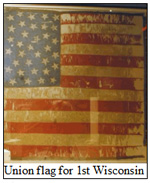 When
the 1st Wisconsin Volunteers signed up for 90 days, they had to wear
grey wool uniforms because there wasn’t enough blue wool. They trained
at Camp Randall, Wisconsin (now home of the Wisconsin Badgers). The
ladies of Kenosha sewed a 34-star Union flag for this unit. On July 2,
1861, this unit fought at the Battle of Falling Waters, Virginia (now
Martinsburg, West Virginia). Fred Malish, a German émigré, had enlisted
for 90 days, but like over two-thirds of his regiment, reenlisted for
three years after his 90 days were up. The flag (left) and Malish’s grey
shell jacket (right) are on display at the Museum. When
the 1st Wisconsin Volunteers signed up for 90 days, they had to wear
grey wool uniforms because there wasn’t enough blue wool. They trained
at Camp Randall, Wisconsin (now home of the Wisconsin Badgers). The
ladies of Kenosha sewed a 34-star Union flag for this unit. On July 2,
1861, this unit fought at the Battle of Falling Waters, Virginia (now
Martinsburg, West Virginia). Fred Malish, a German émigré, had enlisted
for 90 days, but like over two-thirds of his regiment, reenlisted for
three years after his 90 days were up. The flag (left) and Malish’s grey
shell jacket (right) are on display at the Museum.
Samuel Bennett, of Beaver Dam, Wisconsin, wrote eight letters to his
wife, which are on display at the Museum. While one-third of the
Wisconsin boys came from German states, Bennett emigrated from England.
When the war started, Bennett was sent to Southern Mississippi, where he
died of a disease. Benjamin Franklin White was born in Green Bay,
Wisconsin. He and his parents went West on the Oregon Trail. He received
a degree from Read Medical College in 1857. When the war started, he
became a Lieutenant Colonel in the 1st Wisconsin Infantry but went home
after his 90-day enlistment expired. He was then hired as a "contract"
surgeon to treat the 1200 Confederate prisoners held at Camp Randall.
Unfortunately, he died of heat stroke in May 1862.
Peter Ford fought with the 1st Wisconsin (the "Iron Brigade"), an all
western regiment with three Wisconsin, one Indiana and one Michigan
brigades. He was captured and paroled after Antietam but was killed on
July 3, 1863 and is buried in the Gettysburg National Cemetery.
Milwaukee women raised $100,000 to start an asylum for Union soldiers
and sailors. They turned the money over to the Federal Government to
establish the Northwestern branch of the National Soldiers’ and Sailors
Home (now the Clement J. Zablocki VA Medical Center) on 125 rolling
acres in western Milwaukee.
Twelve Union veterans started the Grand Army of the Republic in
Decatur, Illinois. By 1890, the GAR grew to a 400,000-strong Republican
voting bloc and exerted substantial, long-lasting influence on politics,
especially veteran’s pensions. GAR ribbons are displayed at the Kenosha
Museum.
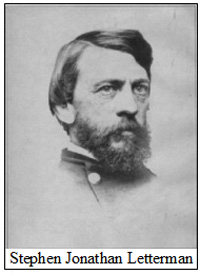 Doug
then turned the podium over to his father. Gordon began by introducing
us to Stephen Jonathan Letterman (1824-72) and William Alexander
Hammond, two true heroes of the Civil War. Known as the "Father of
Modern Battlefield Medicine," Letterman’s work saved thousands of
soldiers from dying horrible deaths on the battlefield. Letterman was
born in Canonsburg, Pennsylvania. His father was a surgeon, and
Letterman followed in his footsteps, graduating from Jefferson Medical
College, in Philadelphia, in 1849. His medical education consisted of
two 8-month terms at which the same classes were repeated. If the
student passed an exam, he received a medical degree. He then joined the
Army and passed a 3-day test (only 9 out of 50 passed!), upon which he
was commissioned as an assistant surgeon in the Army Medical Department.
From then until 1861, Letterman served on various military campaigns
against Native American tribes in Florida, Minnesota, Kansas, New Mexico
and California. With the beginning of the Civil War in 1861, Letterman
was assigned to the Army of the Potomac and was eventually named Medical
Director of the entire army in June 1862, with the rank of Major. After
it took over a week to remove 3,626 casualties from the battlefield at
Second Manassas/Bull Run, Letterman was given free range by General
George McClellan to do whatever was needed to revamp the poor medical
services that the men received in the field. Doug
then turned the podium over to his father. Gordon began by introducing
us to Stephen Jonathan Letterman (1824-72) and William Alexander
Hammond, two true heroes of the Civil War. Known as the "Father of
Modern Battlefield Medicine," Letterman’s work saved thousands of
soldiers from dying horrible deaths on the battlefield. Letterman was
born in Canonsburg, Pennsylvania. His father was a surgeon, and
Letterman followed in his footsteps, graduating from Jefferson Medical
College, in Philadelphia, in 1849. His medical education consisted of
two 8-month terms at which the same classes were repeated. If the
student passed an exam, he received a medical degree. He then joined the
Army and passed a 3-day test (only 9 out of 50 passed!), upon which he
was commissioned as an assistant surgeon in the Army Medical Department.
From then until 1861, Letterman served on various military campaigns
against Native American tribes in Florida, Minnesota, Kansas, New Mexico
and California. With the beginning of the Civil War in 1861, Letterman
was assigned to the Army of the Potomac and was eventually named Medical
Director of the entire army in June 1862, with the rank of Major. After
it took over a week to remove 3,626 casualties from the battlefield at
Second Manassas/Bull Run, Letterman was given free range by General
George McClellan to do whatever was needed to revamp the poor medical
services that the men received in the field.
Before Letterman’s innovations, wounded men were often left to fend
for themselves. Unless carried off the field by a comrade or one of the
regimental musicians doubling as a stretcher bearer, a wounded soldier
could lie for days suffering from exposure, thirst and being burned
alive. Letterman started the very first Ambulance Corps, training men to
act as stretcher bearers and operate wagons to pick up the wounded and
bring them to field dressing stations. He also instituted the concept of
"triage" for treatment of the casualties (dividing casualties into three
groups: can be saved, might be saved and cannot be saved).
Letterman developed an evacuation system that consisted of three
stations:
1) A Field Dressing Station - located on or next to the
battlefield where medical personnel would apply the initial
dressings and tourniquets to wounds.
2) A Field Hospital – located close to the battlefield, usually
in homes or barns, where emergency surgery could be performed and
additional treatment given.
3) A Large Hospital – Located away from the battlefield and
providing facilities for the long term treatment of patients.
In addition to these improvements, Letterman arranged for an
efficient distribution system for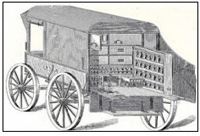 medical supplies; developed a standardized medical box containing 60
different medicines, including condensed milk and coffee grounds,
costing $125 and built by Edward R. Squibb; designed a pharmacy wagon
(right), placed first aid stations within 60 yards of the battle (!);
insisted they be placed in low areas which were safer from shells and
bullets; and as part of triage, bandaged soldiers who could return and
sent them back to the front. On August 27, 1862, Gen. McClellan issued
General Order No. 147, spelling out in great detail how the ambulance
corps and ambulance trains were to be organized and operated.
medical supplies; developed a standardized medical box containing 60
different medicines, including condensed milk and coffee grounds,
costing $125 and built by Edward R. Squibb; designed a pharmacy wagon
(right), placed first aid stations within 60 yards of the battle (!);
insisted they be placed in low areas which were safer from shells and
bullets; and as part of triage, bandaged soldiers who could return and
sent them back to the front. On August 27, 1862, Gen. McClellan issued
General Order No. 147, spelling out in great detail how the ambulance
corps and ambulance trains were to be organized and operated.
The success of the Ambulance Corps was proven at the Battle of
Antietam, September 17, 1862. While there were over 23,000 casualties,
medical personnel were able to remove all of the wounded from the field
in just 24 hours. Within 48 hours, 90% were being treated in one of 34
Union hospitals where there would be fresh water, fresh straw and fresh
food. He set up his own convoy system, manned by men trained to care for
the wounded, unlike the Quarter Master Corpsmen! The trains left for
Middleton, Maryland, where wounded were taken into a church, had their
wounds redressed, and were required to rest for six hours before being
put back on board trains headed for Frederick, Maryland, the "City of
Church Spires." All six churches there were utilized – wooden planks
were laid across the pews. The Catholic Sisters of Charity served as
nurses. In addition, soldiers’ wives and widows were paid 20 cents a day
and trained to be nurses.
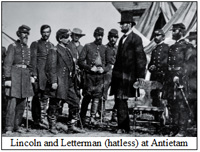 The
morale of the wounded improved, which improved their chances of
surviving. Letterman himself did no cutting. Instead he was like a
symphony conductor. Letterman was extraordinarily energetic and
impatient. In October 1862, President Lincoln visited the Army. There is
a picture (right) of Lincoln and the generals, along with Letterman
(second from left), who looks impatient with the whole process, itching
to get back to work! Lincoln asked Letterman for a tour of the
hospitals, saying he wanted to see the wounded of both sides. The
President knelt beside the cot of a dying 18-year old rebel and had a
private 3-minute conversation. Letterman saw tears in Lincoln’s eyes and
heard him say, "When will this horrible war end?" The
morale of the wounded improved, which improved their chances of
surviving. Letterman himself did no cutting. Instead he was like a
symphony conductor. Letterman was extraordinarily energetic and
impatient. In October 1862, President Lincoln visited the Army. There is
a picture (right) of Lincoln and the generals, along with Letterman
(second from left), who looks impatient with the whole process, itching
to get back to work! Lincoln asked Letterman for a tour of the
hospitals, saying he wanted to see the wounded of both sides. The
President knelt beside the cot of a dying 18-year old rebel and had a
private 3-minute conversation. Letterman saw tears in Lincoln’s eyes and
heard him say, "When will this horrible war end?"
The Battle of Fredericksburg (December 11-15, 1862) (12,000
casualties) tested Letterman’s system to the "max." Within two days
after this disaster ended, Letterman’s team had installed pontoon
bridges across the Rappahannock River; ambulance convoys crossed and
re-crossed the river; and all casualties that could be moved had been
sent to hospitals in Washington, D. C. Letterman established a General
Hospital ("Camp Letterman") about a mile from the battle site and
temporary field hospitals wherever there was a source of water and
shelter. The buildings used included churches, farm buildings and
private homes. Sometimes the only shelter available was a piece of
canvas strung between two trees or poles.
As the Battle of Gettysburg (July 1-3, 1863) approached its end,
there were approximately 22,000 wounded from both the Union and
Confederate armies to deal with. To Letterman, once a man was wounded he
was no longer an "enemy." Medical supplies were running low and the
hardships of the wounded were equally matched with the exhaustion of the
doctors (both Union and Confederate). During the first days of the
battle, Gen. Meade had barred Letterman’s supply wagons from the
battlefield. Meade wanted ammunition and more ammunition, but after 48
hours, Meade relented. Letterman felt devastated by what he called "a
vast sea of misery." Camp Letterman was primitive by modern standards,
but was impressive to the soldiers. Each tent held forty folding cots
with mattresses and sheets--luxuries for soldiers who were used to lying
on hard ground since being wounded. In March of 1864, the system was
officially adopted for the U.S. Army by an Act of Congress.
With his work with the Army Medical Corps completed, and in October
1863, he married Mary Digges Lee, from a wealthy family in Maryland,
with whom he was to have two daughters. After serving a brief period as
Inspector of Hospitals, Letterman resigned from the army in December
1864. He and his family moved to San Francisco where he served as
coroner from 1867 to 1872, and published his memoirs, Medical
Recollections of the Army of the Potomac. In 1872, after the death
of his wife, Letterman became severely depressed. Several illnesses
followed and on March 15, he passed away. He and his wife are buried
side-by-side in Arlington National Cemetery where his gravestone honors
the man "who brought order and efficiency in to the Medical Service and
who was the originator of modern methods of medical organization in
armies."
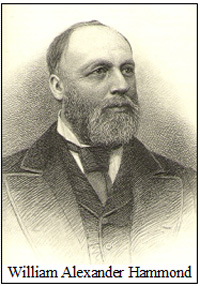 The
story of Civil War battlefield medicine would not be complete without
reference to William Alexander Hammond (1828-1900), then a 34-year old
Brigadier General and the 11th Surgeon General of the Army. Hammond
launched a number of reforms, including raising the requirements for
admission into the Army Medical Corps, weeding out incompetent
"sawbones," increasing the number of hospitals, improving record
keeping, transferring the responsibility for sanitary trains from
private companies to the government and paying close attention to
aeration. Gordon reminded us that to the amazement of old-line doctors,
casualties living outdoors in tents had a better survival record than
casualties packed into fetid barns. Hammond created Satterlee Hospital,
in Philadelphia (which had up to 4,500 beds in hundreds of tents).
Hammond proposed a permanent military medical corps, a permanent
hospital for the military, centralized issuance of medications and
personally oversaw the building of the wagons. He promoted Letterman and
supported his reforms. Efficiency increased, as Hammond promoted people
on the basis of competence, not rank or connections, and his initiatives
were positive and timely. He designed innovative hospitals, using a
wheel and spoke design: The operating rooms were in the center and each
spoke isolated contagious patients. Beds had to be placed a set distance
from each other. Walt Whitman chronicled his experiences in the
Washington, D. C., hospitals. The
story of Civil War battlefield medicine would not be complete without
reference to William Alexander Hammond (1828-1900), then a 34-year old
Brigadier General and the 11th Surgeon General of the Army. Hammond
launched a number of reforms, including raising the requirements for
admission into the Army Medical Corps, weeding out incompetent
"sawbones," increasing the number of hospitals, improving record
keeping, transferring the responsibility for sanitary trains from
private companies to the government and paying close attention to
aeration. Gordon reminded us that to the amazement of old-line doctors,
casualties living outdoors in tents had a better survival record than
casualties packed into fetid barns. Hammond created Satterlee Hospital,
in Philadelphia (which had up to 4,500 beds in hundreds of tents).
Hammond proposed a permanent military medical corps, a permanent
hospital for the military, centralized issuance of medications and
personally oversaw the building of the wagons. He promoted Letterman and
supported his reforms. Efficiency increased, as Hammond promoted people
on the basis of competence, not rank or connections, and his initiatives
were positive and timely. He designed innovative hospitals, using a
wheel and spoke design: The operating rooms were in the center and each
spoke isolated contagious patients. Beds had to be placed a set distance
from each other. Walt Whitman chronicled his experiences in the
Washington, D. C., hospitals.
Sadly, Hammond came a cropper in part due to his impatience with
incompetence. On 4 May 1863 Hammond banned the mercury compound calomel,
a purgative, from army supplies, as he believed it to be neither safe
nor effective (he was later proved correct). He thought it dangerous to
make an already debilitated patient vomit. A "Calomel Rebellion" ensued,
as many doctors saw the move as "infringing" on their liberty of
practice. Hammond's arrogant nature did not help him solve the problem,
and his relations with Secretary of War Stanton became strained. On
September 3, 1863 he was sent on a protracted "inspection tour" to the
South, effectively removing him from office. Joseph Barnes, a friend of
Stanton's and his personal physician, became acting Surgeon General.
Hammond demanded to be either reinstated or court-martialed. A
court-martial found him guilty of "irregularities" in the purchase of
medical furniture on the basis of "false data." Hammond was dismissed
from the Army on August 18, 1864. He went on to a varied and successful
career and is also buried in Arlington.
 Gordon
said the Civil War was a turning point in the history of medicine.
Before, hospitals were referred to as "pest houses" and the sick and
injured were well-advised to insist on home care. Things changed slowly:
Dr. Oliver Wendell Holmes once said, "All the drugs used by the armies
should be thrown into the ocean. Of course, all the fish would then
die!" In 1860, there was one Federal hospital, in Fort Leavenworth,
Kansas. In Washington, D. C., alone, 26 hospitals were set up! Hundreds
of hospitals sprouted up around the Confederacy. The five converging
railroads at Richmond, and the city’s proximity to the Eastern
battlefields, meant that Richmond, Virginia, became a booming hospital
center. No medical facility anywhere on the continent during the Civil
War equaled the fame of Chimborazo Hospital as one of the largest,
best-organized, and most sophisticated hospitals in the Confederacy. It
served as a convalescent hospital, treating wounded who had received
medical treatment elsewhere. During the war, it is estimated that 75,000
men were treated, of whom 5,000 to 7,000 died. From 1861 on, Dr. James
B. McCaw, a young resident of Richmond, ran the hospital (right), which
had its own dairy and vegetable garden and butchered its own beef. It
was built on top of a hill to escape some of Richmond’s summer heat. Gordon
said the Civil War was a turning point in the history of medicine.
Before, hospitals were referred to as "pest houses" and the sick and
injured were well-advised to insist on home care. Things changed slowly:
Dr. Oliver Wendell Holmes once said, "All the drugs used by the armies
should be thrown into the ocean. Of course, all the fish would then
die!" In 1860, there was one Federal hospital, in Fort Leavenworth,
Kansas. In Washington, D. C., alone, 26 hospitals were set up! Hundreds
of hospitals sprouted up around the Confederacy. The five converging
railroads at Richmond, and the city’s proximity to the Eastern
battlefields, meant that Richmond, Virginia, became a booming hospital
center. No medical facility anywhere on the continent during the Civil
War equaled the fame of Chimborazo Hospital as one of the largest,
best-organized, and most sophisticated hospitals in the Confederacy. It
served as a convalescent hospital, treating wounded who had received
medical treatment elsewhere. During the war, it is estimated that 75,000
men were treated, of whom 5,000 to 7,000 died. From 1861 on, Dr. James
B. McCaw, a young resident of Richmond, ran the hospital (right), which
had its own dairy and vegetable garden and butchered its own beef. It
was built on top of a hill to escape some of Richmond’s summer heat.
Gordon is too humble to talk about his role in founding the National
Museum of Civil War Medicine, Frederick, Maryland, so your Editor took
the liberty of going to its website for the story:
"The creation of The National Museum of Civil War Medicine started as
the idea of Gordon E. Dammann, D.D.S., whose collection of medical
artifacts from the Civil War forms the core of the Museum’s holdings.
Dr. Dammann had begun collecting in 1971 and around 1990 felt that a
museum would be a good way to share his collection and the story of
Civil War medicine with the public. With the help of other doctors and
the support of the Governor of Maryland and the Mayor and Aldermen of
Frederick, what began as Gordon’s private collection of medical
artifacts from the Civil War has grown into an organization (that opened
its doors to the public on June 15, 1996) as vital and relevant as the
plan that Dr. Jonathan Letterman developed nearly 150 years ago while at
the Pry House on the Antietam battlefield. The legacy of the Letterman
Plan breathes life into the artifacts preserved and interpreted at the
Museum’s main site in Frederick, Maryland, and two satellite museums:
the Pry House Field Hospital Museum, Antietam, Maryland (next page), and
Clara Barton’s Missing Soldiers Office in Washington, D. C. The
Letterman Institute of Professional Development offers speakers and
seminars and the Museum also has a publishing center.
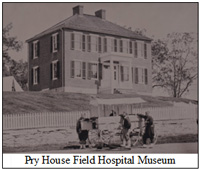 "Visitors
will find a unique center of Civil War history, guiding "Visitors
will find a unique center of Civil War history, guiding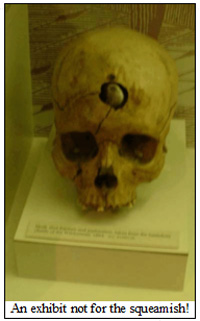 them through 150 years of medical history as well as Civil War camp
life, hospital life, African American life, the role of women and
children during the war, and many more aspects of American history
during the Civil War era. The Museum highlights the challenges faced by
Civil War doctors and surgeons and the resulting innovations that led to
the today’s modern military medical system. Our museum sites begin with
displays and artifacts highlighting general medicine in the 1800s
progressing into wartime medicine and civilian life. We look at the
faces of those who were treated and their caregivers. Reading their
stories and memories puts a human face on the medicine of the time. A
space in each museum is dedicated to Dr. Letterman, Medical Director of
the Army of the Potomac. His cohesive plan of triage, evacuation,
hospital and supply organization not only saved the lives of countless
Civil War soldiers, it continues to save lives on today’s battlefields
in Iraq, Afghanistan, and in civilian life wherever emergency medical
help is needed.
them through 150 years of medical history as well as Civil War camp
life, hospital life, African American life, the role of women and
children during the war, and many more aspects of American history
during the Civil War era. The Museum highlights the challenges faced by
Civil War doctors and surgeons and the resulting innovations that led to
the today’s modern military medical system. Our museum sites begin with
displays and artifacts highlighting general medicine in the 1800s
progressing into wartime medicine and civilian life. We look at the
faces of those who were treated and their caregivers. Reading their
stories and memories puts a human face on the medicine of the time. A
space in each museum is dedicated to Dr. Letterman, Medical Director of
the Army of the Potomac. His cohesive plan of triage, evacuation,
hospital and supply organization not only saved the lives of countless
Civil War soldiers, it continues to save lives on today’s battlefields
in Iraq, Afghanistan, and in civilian life wherever emergency medical
help is needed.
"The interactive experience that is the National Museum of Civil War
Medicine not only gives a snapshot of Civil War medicine, including
dentistry, veterinary medicine and medical evacuation, it allows
visitors to put faces and names to those who fought, were injured, the
surgeons and caregivers who tended them. The experience is a personal
one, engaging visitors in the stories of soldiers, surgeons, hospital
stewards, nurses and those who volunteered, as they gain an
understanding of the medical advances of the time. For some, a bit of
family history may be found as well."
Following an extended question-and-answer period, Dammann father and
son received a well-deserved round of applause.
[Editor’s addendum: The May 27, 2014, The New York Times
had a story on Andrew Carroll, an author and instructor at Chapman
University, Orange, California, who at his own expense, installs plaques
commemorating undeservedly overlooked people. One of his heroes was Dr.
Thomas Holmes, the "Father of American Embalming," who developed a more
efficient technique to preserve the remains of soldiers killed during
the Civil Wars, starting in 1861 when he embalmed the remains of Col.
Elmer Ellsworth, the first Union soldier killed in the war. His process
permitted the remains of thousands of soldiers to be sent home for
burial.]
[Free blurb for NMCWM: "Civil War Medicine…it’s not what you
think! Come learn the facts at the Twenty-second Annual Conference
on Civil War Medicine, Friday-Sunday, Oct. 3-5, 2014. The National
Museum of Civil War Medicine has assembled an impressive panel of
prominent historians, authors, and medical professionals speaking on a
wide variety of topics relating to Civil War medicine. Highlights of the
conference include eleven unique lectures on Friday, Saturday and
Sunday, and a special bus tour of the hospital and medical sites in
Kennesaw, GA. Back by popular demand is our Thursday evening
pre-conference program. Conference attire is casual. Period clothing is
welcome at the Saturday dinner. For further information, contact Tom
Frezza, PryHouse@civilwarmed.org, or call 301-695-1864, ext. 14."]
Last changed: 06/11/14
Home
About News
Newsletters
Calendar
Memories
Links Join
|

